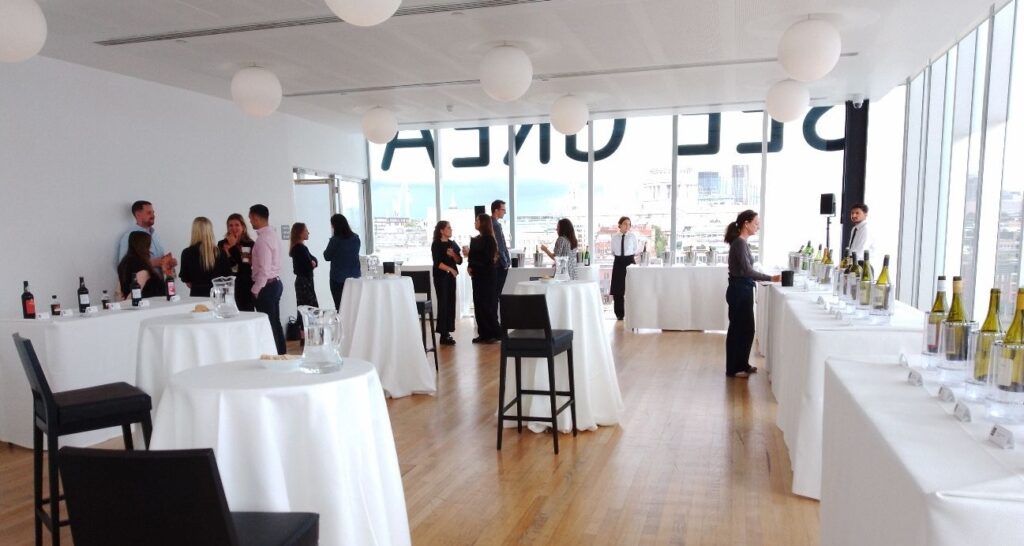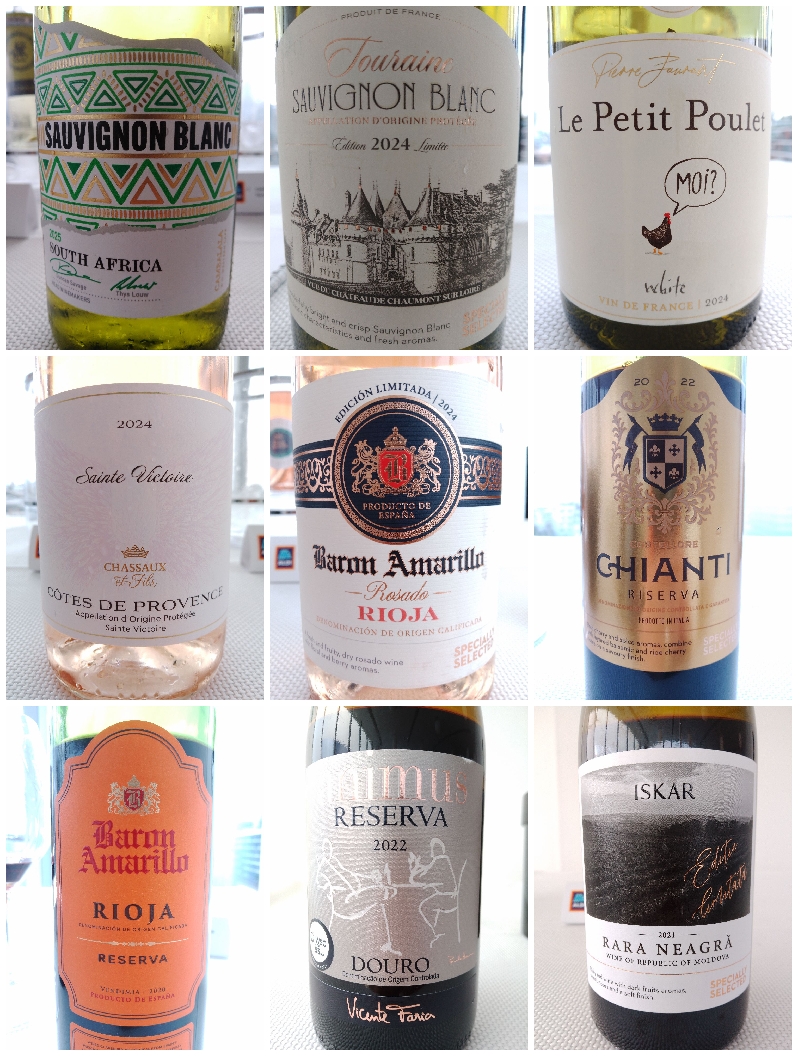
Aldi’s wine press tasting was at Tate Modern in London, my first press tasting of the Autumn–Winter ’25 season. The tasting was smaller than usual at around sixty-five wines plus a handful of fortifieds. The wines shown were mainly seasonal and what’s arriving soon, rather than in the core range.
We were told Rosé has been a big success for Aldi over the past year. Also, Veuve Monsigny’s recent win at the World’s Best Champagne awards has driven an 80% uplift in sales. With the cost of living still biting, Aldi expects the night-in to keep outpacing the night-out, so there’s a clear emphasis on wines that pull their weight at the table.
These are the wines I found particularly notable:

Cambalala South African Sauvignon Blanc 2025, 12.5% abv, £5.99.
A 100% Sauvignon Blanc that opens with aromatic tropical notes and follows through with tropical and lime on a fuller-bodied taste than is usual for Sauvignon Blanc. There’s a lovely mouthfeel and the faintest off-dry impression without losing freshness. I am seeing a growing trend for mass-market, more tropical, more round, slightly sweet, Sauvignon Blanc from South Africa.
Core line, available now, and excellent value.
Specially Selected Touraine Sauvignon Blanc 2024, 12.0% abv, £7.49.
New to Aldi and sourced from Mouzillon in the Loire. Another 100% Sauvignon Blanc, but a very different expression. Intense apricot and apple on the nose, then a concentrated peach-and-apple burst for the taste. The finish is long, with a very slight sweetness balanced by a late-arriving acidity. A vivid, intense and food-friendly style – I tried it with the lunch platter.
Seasonal line, from September 2025.
Pierre Jaurant Le Petit Poulet Blanc 2024, 11.0% abv, £6.29.
New to Aldi and built from a very broad blend: 31% Ugni Blanc, 25% Grenache Blanc, 21% Clairette, 9% Vermentino, 7% Sauvignon Blanc and 7% Colombard. Aromatic, with a hint of honeysuckle. The flavours are generous yet hard to pin down precisely, no surprise given the large grape mix. It also comes across a touch sweeter than the declared low sugar in the tasting notes would suggest. It’s very drinkable, with good mouthfeel and balance even if it resists easy categorisation.
Seasonal line, from September 2025.
Chassaux et Fils Sainte-Victoire Côtes de Provence Rosé 2024, 12.5% abv, £10.99.
New to Aldi. A classic southern blend of 69% Grenache, 20% Syrah, 9% Cinsault and 2% Rolle. Silver at the International Wine Challenge 2025 and also Silver at the Global Rosé Masters. Very floral on the nose, with ripe red fruit on the palate. The mid-palate has real presence and for a rosé the length is striking. Acidity, body and balance are all in place.
Seasonal line, from September 2025.
Specially Selected Rioja Rosado 2024, 13.0% abv, £6.99.
New Rosé to Aldi and made from 51% Tempranillo, 25% Viura, 19% Garnacha, 3% Tempranillo Blanco and 2% Mazuelo. Extremely aromatic, think peach and pear-drop, before shifting to bright red fruit, balanced acidity and a very satisfying mouthfeel. It tastes a touch sweeter than it declares it is, but the overall poise is excellent and a clear step up on Aldi Rosado from previous years.
Seasonal line, from September 2025.
Specially Selected Chianti Riserva DOCG 2022, 13.0% abv, £6.99.
Predominantly Sangiovese (70%) with the remainder other DOCG-permitted varieties. There’s a slight brownish tint hinting at the style to come. The aroma is strong on cherry with a very spicy backdrop. The taste brings wood, cherry and medium tannins, finishing savoury. It benefits from air and even softened over the course of the tasting. A lovely, unusual, more savoury, example of Chianti at an everyday price.
Seasonal line, from September 2025.
Baron Amarillo Rioja Reserva 2020, 13.5% abv, £5.99.
100% Tempranillo and already showing some browning at the rim. The classic cherry-led Rioja aroma is spot on. Tannins are medium, noticeably firmer than previous vintages and the taste runs to vanilla, oak and blackcurrant, though less forcefully than previous vintages. I chose it chiefly for that great, intense aroma.
Core line, available now.
Animus Douro Reserva 2022, 13.5% abv, £6.99.
From Vicente Faria Vinhos and blended from 40% Tinta Roriz, 30% Touriga Nacional and 30% Touriga Franca. Similar profile to the Animus I reviewed, though this Reserva shows a little less complexity, more oak and slightly softer tannins.
Seasonal line, from September 2025.
Specially Selected Moldovan Rară Neagră 2021, 13.5% abv, £7.99.
Composed of 85% Rară Neagră, 10% Merlot and 5% Cabernet Sauvignon. The aroma brings ripe dark fruit with a lovely thread of smokiness. The taste has sweet-toned notes, as the label suggests, without being actually sweet and it’s intriguingly different. Tannins are medium, the aftertaste lingers and it seemed to grow in stature, after airing, when I returned at the end of the tasting with huge aroma, slightly less tannins and a very woody finish. My favourite of the tasting because it’s different and genuinely fun for curious wine drinkers.
Seasonal line, from September 2025.
Taken together, this line-up delivers on the promise of more food-friendly choices. The rosés are more flavoursome and structured, while many of the reds lean into tannin and savoury detail without becoming austere. The Moldovan Rară Neagră was a real find and it’s great to see Aldi continue to experiment to keep things interesting.
Most of these wines are seasonal, so please check the availability dates above and be aware that prices are subject to change.














